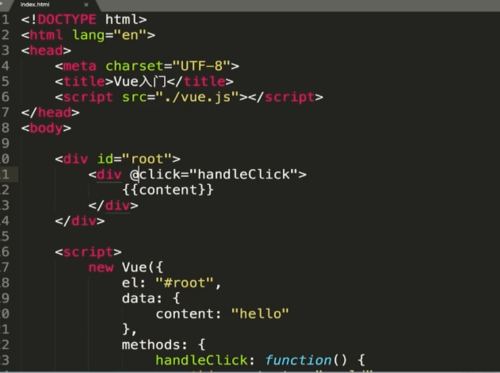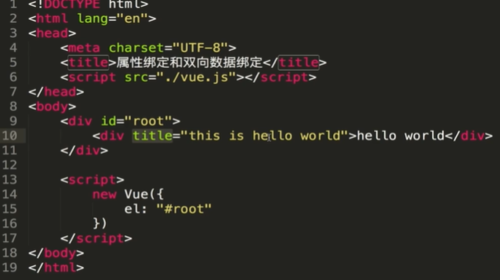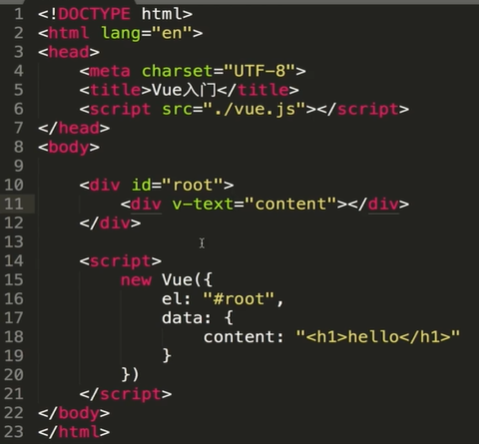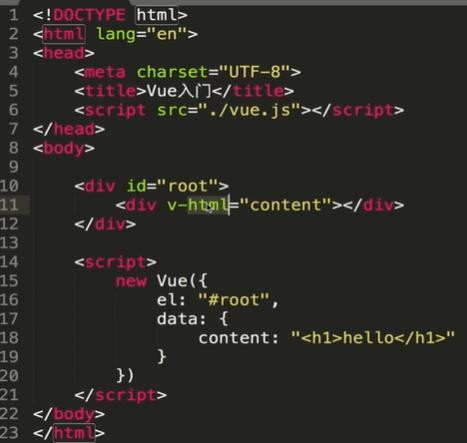-
 @click=v-on:click
@click=v-on:clickclick绑定事件 方法写在vue中methods
写完一个data或者el后边加上,
this.content可以直接修改content值
查看全部 -
v-if 会将标签移除 销毁和重建dom 适合一次隐藏 v-show 给标签添加display:none 适合多次显示隐藏查看全部
-
事件绑定 v-on: 简写 @ 属性绑定 v-bind: 简写 : 双向数据绑定 v-model查看全部
-
面向数据,无需操作DOM查看全部
-
1. vue.js引入放在head中防止抖屏 2. v-text会转义 v-html不转义查看全部
-
<div id="root"> <div> <input v-model="inputValue"/> <button @click="handleSubmit">提交</button> </div> <ul> <todo-item v-for="(item,index) of list" :key="index" :content="item" :index="index" @delete="handleDelete" > </todo-item> </ul> </div> <script> //全局组件 Vue.component('todo-item',{ props:['content','index'], template:'<li @click="handleClick">{{content}}</li>', methods:{ handleClick:function(){ this.$emit('delete',this.index) } } }) new Vue({ el:"#root", data:{ inputValue:'', list:[] }, methods:{ handleSubmit:function(){ this.list.push(this.inputValue) this.inputValue='' }, handleDelete:function(index){ this.list.splice(index,1) } } }) </script>定义在父模板里的方法,就是在父组件里面执行的。
父组件通过属性的形式向子组件传递数据;子组件通过发布事件,父组件订阅事件,来实现子组件向父组件传递数据。
查看全部 -
每一个Vue组件都是一个Vue的实例,每一个Vue项目都是由千千万万个Vue实例组成的。
一个根实例,如果没有定义模板,那么会把挂载点下的内容都作为模板来使用。
查看全部 -
<div id="root"> <div> <input v-model="inputValue"/> <button @click="handleSubmit">提交</button> </div> <ul> <todo-item v-for="(item,index) of list" :key="index" :content="item" > </todo-item> </ul> </div> <script> //全局组件 Vue.component('todo-item',{ props:['content'], template:'<li>{{content}}</li>' }) new Vue({ el:"#root", data:{ inputValue:'', list:[] }, methods:{ handleSubmit:function(){ this.list.push(this.inputValue) this.inputValue='' } } }) </script>查看全部 -
<div id="root"> <div> <input v-model="inputValue"/> <button @click="handleSubmit">提交</button> </div> <ul> <todo-item></todo-item> </ul> </div> <script> //全局组件 Vue.component('todo-item',{ template:'<li>item</li>' }) //局部组件 //var TodoItem={ // template:'<li>item</li>' //} new Vue({ el:"#root", //components:{ // 'todo-item':TodoItem //}, data:{ inputValue:'', list:[] }, methods:{ handleSubmit:function(){ this.list.push(this.inputValue) this.inputValue='' } } }) </script>将li标签拆成一个组件。
查看全部 -
<div id="root"> <div> <input v-model="inputValue"/> <button @click="handleSubmit">提交</button> </div> <ul> <li v-for="(item,index) of list" :key="index"> {{item}} </li> </ul> </div> <script> new Vue({ el:"#root", data:{ inputValue:'', list:[] }, methods:{ handleSubmit:function(){ this.list.push(this.inputValue) this.inputValue='' } } }) </script>查看全部 -
v-if:
<div id="root"> <div v-if="show">hello world</div> <button @click="handleClick">toggle</button> </div> <script> new Vue({ el:"#root", data:{ show:true }, methods:{ handleClick:function(){ this.show=!this.show; } } }) </script>v-show:
<div id="root"> <div v-show="show">hello world</div> <button @click="handleClick">toggle</button> </div> <script> new Vue({ el:"#root", data:{ show:true }, methods:{ handleClick:function(){ this.show=!this.show; } } }) </script>v-if和v-show的区别:
当v-if定义的数据项的值为false,就移除所在的dom标签。
当v-show定义的数据项的值为false,不会移除标签,只是将标签的display属性设置为none。
v-for:
<div id="root"> <div v-show="show">hello world</div> <button @click="handleClick">toggle</button> <ul> <li v-for="(item,index) of list" :key="index">{{item}}</li> </ul> </div> <script> new Vue({ el:"#root", data:{ show:true, list:{1,2,3} }, methods:{ handleClick:function(){ this.show=!this.show; } } }) </script>v-for可以用来作页面上数据的循环展示
v-if:控制dom的存在与否
v-show:控制dom的显示与否
v-for:控制一组数据在页面上的显示
查看全部 -
计算属性:
以下例子中fullname作为一个计算属性。
<div id="root"> 姓:<input v-model="firstName"/> 名:<input v-model="lastName"/> <div>{{fullName}}</div> </div> <script> new Vue({ el:"#root", data:{ firstName:'', lastName:'' }, computed:{//表示一个属性由其他属性计算而来 fullName:function(){ return this.firstName+' '+this.lastName } } }) </script>计算属性的两个数据项没有发生变化时,它不会再次进行计算,会使用上次计算结果的缓存来赋值给计算属性。
侦听器:监听某一个数据或者计算属性,若其发生变化,就可以在侦听器里写业务逻辑。
<div id="root"> 姓:<input v-model="firstName"/> 名:<input v-model="lastName"/> <div>{{fullName}}</div> <div>{{count}}</div> </div> <script> new Vue({ el:"#root", data:{ firstName:'', lastName:'' }, computed:{//表示一个属性由其他属性计算而来 fullName:function(){ return this.firstName+' '+this.lastName } }, watch:{ firstName:function(){ this.count++ }, lastName:function(){ this.count++ } } }) </script>更为简单的写法:直接监听计算属性fullName
<div id="root"> 姓:<input v-model="firstName"/> 名:<input v-model="lastName"/> <div>{{fullName}}</div> <div>{{count}}</div> </div> <script> new Vue({ el:"#root", data:{ firstName:'', lastName:'' }, computed:{//表示一个属性由其他属性计算而来 fullName:function(){ return this.firstName+' '+this.lastName } }, watch:{ fullName:function(){ this.count++ } } }) </script>查看全部 -
title(提示语)的使用:


属性绑定:
将标签里的title属性和实例里的title数据项的值绑定。
使用模板指令,类似v-bind:title="...",...中的内容就变成了js语句
v-bind:可以简写为:
<div> <div :title="title">hello world</div> </div> <script> new Vue({ el:"#root", data:{ title:"this is hello world" } }) </script>单向绑定:数据决定页面的显示,页面无法改变数据的内容。
双向绑定:v-model
本文框里的内容改变的时候,div里的content内容改变。
div里的content有内容的时候,本文框里的内容也会改变。
<div> <div :title="title">hello world</div> <input v-model="content"/> <div>{{content}}</div> </div> <script> new Vue({ el:"#root", data:{ title:"this is hello world" content:"this is content" } }) </script>查看全部 -
插值表达式:{{...}}
<div id="root"> <h1>{{number}}</h1> </div> <script> new Vue({ el:"root" data:{ number:123 } }) </script>v-text和v-html的区别:
v-html不会转译,v-text会进行一次转译。

结果:<h1>hello</h1>

结果:hello
给div标签绑定事件(v-on):
"v-on:"的简写是@
<div id="root"> <div v-on:click="handleClick">{{content}}</div> </div> <script> new Vue({ el:"#root", data:{ content:"hello" }, methods:{ handleClick:function(){ this.content="world" } } }) </script>查看全部
举报




